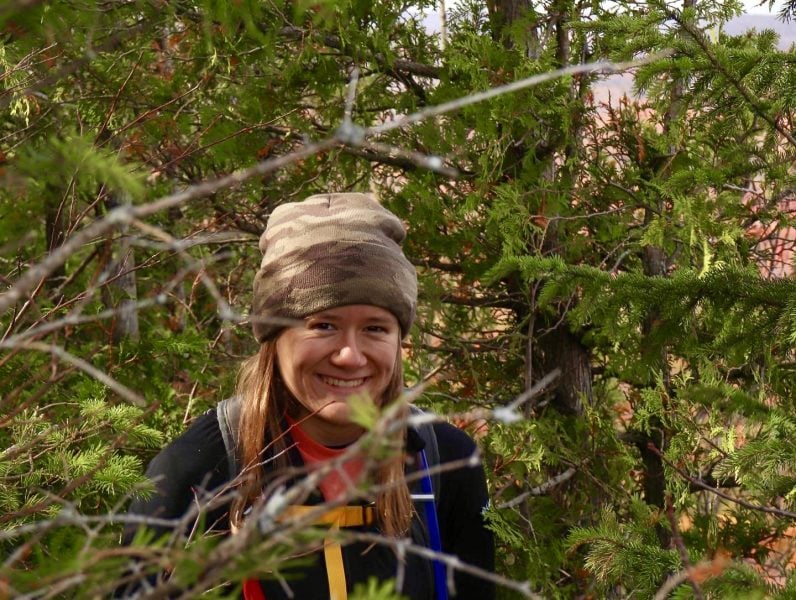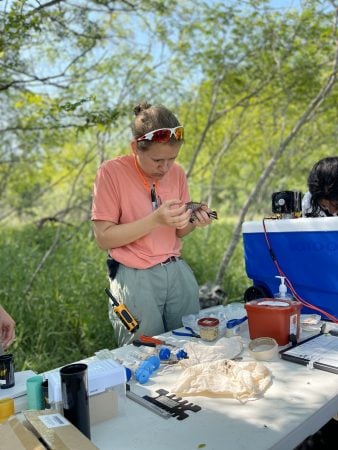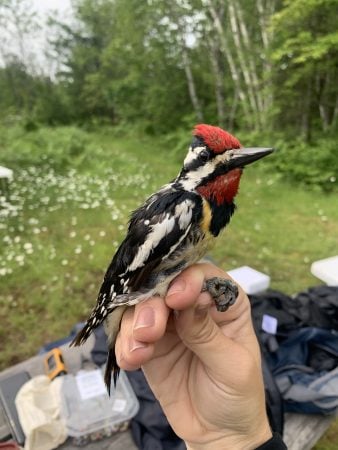
Wildlife ecology and conservation major and bird bander Maggie Guinther can vividly describe what it feels like to hold a bird. Warblers are very soft. Robins are known for pooping all over everything. Her first bird banded was a dark-eyed Junco. But it’s not just about species characteristics. Birds, like people, are highly individual. They might feel some type of way about being handled or be super chill. No matter how they’re reacting, Guinther approaches her task at hand with joy, compassion, and a sense of purpose. In Guinther’s own words, she shares how she began her work last summer and where it led the graduating senior.
Maggie’s Story: How Bird Banding Led to a Deeper Research Experience
“When I started work as an assistant bird bander at Michigan Technological University (MTU) last summer, I never thought it would lead to a senior research thesis. As a rising fourth-year, I was set to be part of our capstone class and follow the track of many other wildlife ecology and conservation majors at MTU. I thought that was just the way it would go, and that specialized research wouldn’t come into play until grad school.

Alt text: A young researcher in the center of the photo holds a bird for banding as she works with other researchers who have measuring equipment laid out on a picnic table with a blue cooler to the side and small trees and grasses in the background.
“Bird banding research is unique because it allows for close, in-hand observation of live birds, which is an experience most people never have. I had the opportunity to work at Michigan Tech’s banding stations, which are mostly within 15 minutes of Houghton. We also have a station at the Ford Center. The days spent there often started earlier and ended later than our regular days because of the extra travel time.”
“We attach aluminum bands of varying sizes to the bird’s leg. Each band has a different number on it, allowing us to identify those birds if we catch them again. I have even seen some of our banded birds in the wild! After banding, we collect data such as weight, wing length, and which feathers the birds are growing in. This allows us to quickly determine how old the bird is and whether it’s male or female. We also take blood, feather, and fecal samples from the birds if possible. Then we release them back on their journey.
“I quickly fell in love with bird banding and realized that I wanted to do more with it. That’s when I heard about an alternative to capstone: senior research thesis. It provides opportunities for students to pursue research in a more in-depth and comprehensive way than capstone courses. “There was just one problem: the deadline to apply for a substitution had passed months ago and the start of the fall semester was quickly approaching. With the help of my co-advisors, Jared Wolfe and Kristin Brzeski, along with my advisor Kat Hanson, we pushed the plan for my senior project through the committee just in time for me to start my research.
“My senior project was supposed to look at a small, charismatic warbler that I like to think of as ‘the Halloween bird.’ American Redstarts (Setophaga ruticilla) were one of our most commonly captured birds for the whole summer. They breed in the Northern United States and much of Canada, migrating to and from the Caribbean, Central America, and northern South America. During this migration pattern, they stop frequently to refuel, along with many other migratory birds.
“I wanted to get a closer look at what they are eating to see why they choose to stop where they do. To do this, I was going to use DNA metabarcoding to study their diet. The way we do this is by extracting DNA from the fecal samples we collect and then using primers to identify the different taxa that are present. From there, we attach barcodes to each strand of DNA and when complete, we will be able to tell what some components of their diet were.
“However, we quickly learned that the amount of time I had for my thesis wasn’t going to fit in the lengthy metabarcoding timeline. So we pivoted. While still keeping the greater goals of the original idea in mind, we decided to focus on optimizing the primers to see what composition of primer and other reaction ingredients yielded the best results. This way, when I or another researcher goes to pick apart a bird diet, an important and lengthy step in the process is already completed.
“These studies are crucial because a better understanding of bird migration as a whole will contribute to a better understanding of what influences migration across other species around the world, which will lead to more comprehensive management and conservation plans. Those plans will make sure that I can keep showing people how amazing birds are far into the future.
“I’m very excited, but also very nervous about graduation. I’m going to be bird banding again this summer with the Wolfe Lab and I am SO excited to have the opportunity to continue working with the lab! Everybody in it has an incredible wealth of knowledge and they’re also just great people! I don’t know what I’m doing after October of this year, but I’m looking forward to the adventure! I’d love to use the freedom I have now to travel for work, so we will see where it takes me.”
Students Learn How to Communicate Their Research
Guinther wrote about her experience learning to band birds and collect morphological data for a stopover habitat study as part of a project in FW4800, a natural resource communications course required for all CFRES seniors. We’re grateful to the students willing to share the communications projects they created for the class, taught by CFRES Assistant Professor Sarah Hoy, and look forward to featuring more of their stories in our CFRES news blog in the future.
About the College of Forest Resources and Environmental Science
Michigan Tech’s College of Forest Resources and Environmental Science brings students, faculty, and researchers together to measure, map, model, analyze, and deploy solutions. The College offers six bachelor’s degrees in forestry, wildlife ecology and conservation, applied ecology and environmental science, natural resources management, sustainable bioproducts, and environmental science and sustainability. We offer graduate degrees in applied ecology, forest ecology and management, forest molecular genetics and biotechnology, and forest science.
Questions? Contact us at forest@mtu.edu. Follow us on Facebook, Instagram, and LinkedIn for the latest happenings.
